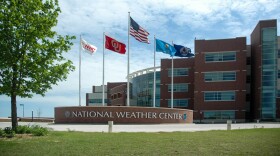Unmanned aerial vehicles, or drones, could help scientists forecast where and when thunderstorms develop, before storm even occur. Experiments are ongoing, and optimism is high.
In the middle of a dusty field, a researcher rips some velcro off a tarp holding a big, white weather balloon.
The balloon quickly takes off, bobbing and weaving in the northern Oklahoma wind.
Meteorologists have been using what’s called radiosonde balloons for decades. They carry sensors to measure things like temperature, humidity and pressure.
Steve Koch, the director of the National Oceanic and Atmospheric Administration's National Severe Storm Laboratory, says balloons get the job done. However, they can be kind of clunky.
“You have to have one or two people launching them, and the balloons drift with the wind so you're not actually measuring what's happening at a point. It's going to be drifting downwind with time and the higher up, it goes the further downwind it might be,” Koch said.
Weather balloons are expensive, they’re only used once, and most of the sensors are lost. They collect data while travelling up to 30,000 feet, but Koch says there are some questions about the usefulness of data from such a high altitude. Most storms develop in lower levels of the atmosphere, below 6,000 feet.
Koch is the lead researcher for a project using unmanned aerial vehicles, or drones, to gather measurements from the atmosphere, which recently performed several days of experiments at Mesonet sites near Enid, Oklahoma, about 100 miles northwest of Oklahoma City. The Oklahoma Mesonet is a network of 121 weather sensors scattered across the state.

“We're trying to explore now is whether we can use drones to supplement or even replace the need to launch balloons by hand, and more frequently,” Koch said.
As part of the experiment, researched launched copter drones every 30 minutes to profile a column of air. The drones, which were designed and built by University of Oklahoma students, look like little metal flying boxes with six propellers.
“So what we're trying to do is fill a void in observing the atmosphere at scales that are really essential for thunderstorms to develop,” Koch said.
Drones can get precise data about the lower atmosphere before a storm is born. That sets them apart from other available technologies. Radar, for example, tracks where a storm is and where it is has been, but radar doesn’t provide information before a storm occurs. Satellites give valuable data about upper levels of the atmosphere, but they can’t penetrate below thick clouds.
“We're trying to do is look at the environment before the first thunderstorm, before the first cumulonimbus cloud forms. And we want to know if a cloud like that is going to form, if, then where and when it will form. We call it pre-convective. So not once the storm has developed but before,” Koch said.
A team researchers from the University of Colorado has also been experimenting near Enid with drones. They use a different type of unmanned aerial vehicle -- a fixed wing drone, that looks like a little yellow plane that’s launched from the roof of an SUV.
CU lead researcher Brian Argrow says his drone can fly close to dangerous storms where it isn’t safe for humans. And, it can fly over greater distances than a copter drone.
“What we provide is the ability then to look at things, how they vary spatially, from one point to another, not at just one point,” Argrow said.
Together, the two types of drones provide a mountain of new data that meteorologists could potentially use to improve short-term forecasts and more precisely predict exactly where and when a storm could develop.
But just like anything that flies, there are rules. Federal Aviation Administration regulations limit drones below 2500 feet. And the FAA also requires several people be on site for each flight, including a trained pilot.
Those limitations get in the way of Steve Koch’s big plans for drones. Eventually, he would like regularly-scheduled copter drones to launch autonomously from every Mesonet site in the state.
“Imagine the possibility of measuring the lowest several thousand feet - maybe 5000 feet, every 30 minutes or even every 15 minutes. You get tremendous amount of data that we don't have currently that says where thunderstorms would form, if they're going to form, where and when they would form,” Koch said.
But before that could happen, regulations would need to catch up with the technology.
As a community-supported news organization, KGOU relies on contributions from readers and listeners to fulfill its mission of public service to Oklahoma and beyond. Donate online, or by contacting our Membership department.








